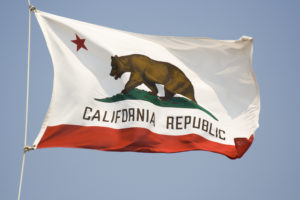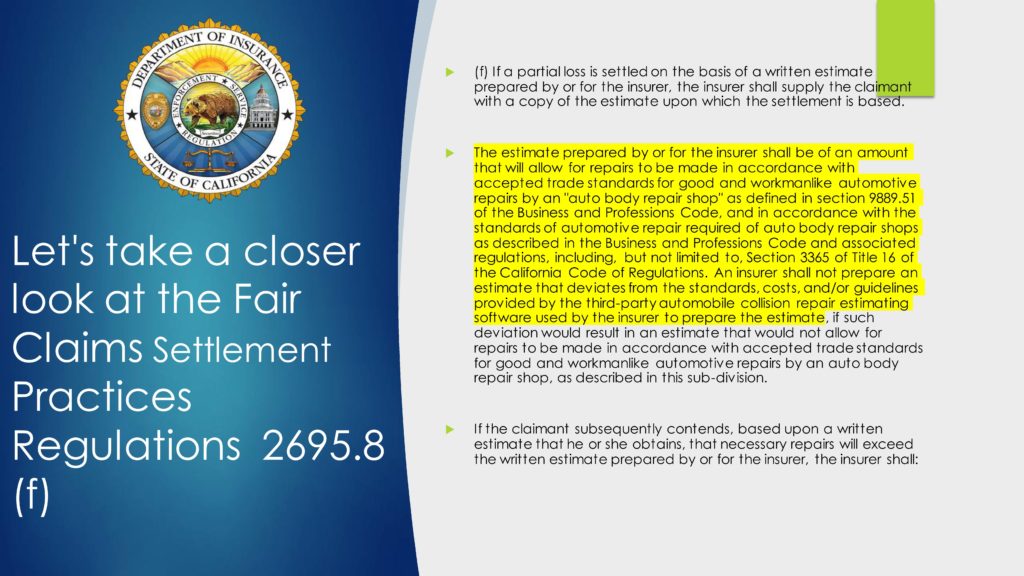
Presentation shows how Calif. industry standard for body shops, insurers is OEM procedures
By onAnnouncements | Associations | Business Practices
A new presentation created by a California auto body shop offers an easy way of proving that Golden State law demands both repairers and insurers comply with OEM procedures.
The shop, which requested anonymity, said fellow repairers could also use its “What is Industry Standards?” PowerPoint slides. The shop said the content had a successful review by an attorney.
The slideshow points out two key components of California law.
The accepted trade standards for good and workmanlike auto body and frame repairs shall include, but not be limited to, the following:
(a) Repair procedures including but not limited to the sectioning of component parts, shall be performed in accordance with OEM service specifications or nationally distributed and periodically updated service specifications that are generally accepted by the autobody repair industry.
(b) All corrosion protection shall be applied in accordance with manufacturers’ specifications or nationally distributed and periodically updated service specifications that are generally accepted by the autobody repair industry. (Emphasis added.)
The repairer’s presentation offers I-CAR as an example of “nationally distributed and periodically updated service specifications that are generally accepted by the autobody repair industry.” I-CAR has since at least 2013 declared automaker repair procedures the way to fix vehicles, calling them “service specifications” in 2017.
The Society of Collision Repair Specialists, Alliance of Automotive Service Providers, Automotive Service Association and Assured Performance in 2011 joined together to state that “we hereby recognize published repair procedures, as provided by the Automobile Original Equipment Manufacturers (OEM), as the official industry recognized repair standards for collision repair.” Many state trade associations have also signed on to that sentiment.
So collision repairers are indeed held to an “industry standard” of following OEM procedures. What about auto insurers and their estimates?
As the shop pointed out, 10 CCR 2695.8(f) among the “Fair Claims Settlement Practices Regulations” ties insurers to the body shops’ “trade standards” as well:
(f) If a partial loss is settled on the basis of a written estimate prepared by or for the insurer, the insurer shall supply the claimant with a copy of the estimate upon which the settlement is based. The estimate prepared by or for the insurer shall be of an amount that will allow for repairs to be made in accordance with accepted trade standards for good and workmanlike automotive repairs by an “auto body repair shop” as defined in section 9889.51 of the Business and Professions Code, and in accordance with the standards of automotive repair required of auto body repair shops as described in the Business and Professions Code and associated regulations, including, but not limited to, Section 3365 of Title 16 of the California Code of Regulations. An insurer shall not prepare an estimate that deviates from the standards, costs, and/or guidelines provided by the third-party automobile collision repair estimating software used by the insurer to prepare the estimate, if such deviation would result in an estimate that would not allow for repairs to be made in accordance with accepted trade standards for good and workmanlike automotive repairs by an auto body repair shop, as described in this subdivision. If the claimant subsequently contends, based upon a written estimate that he or she obtains, that necessary repairs will exceed the written estimate prepared by or for the insurer, the insurer shall:
(1) pay the difference between the written estimate and a higher estimate obtained by the claimant; or,
(2) if requested by the claimant, promptly provide the claimant with the name of at least one repair shop that will make the repairs for the amount of the insurer’s written estimate. The insurer shall cause the damaged vehicle to be restored to its condition prior to the loss at no additional cost to the claimant other than as stated in the policy or as otherwise allowed by law. The insurer shall maintain documentation of all such communications; or,
(3) reasonably adjust any written estimates prepared by the repair shop of the claimant’s choice and provide a copy of the adjusted estimate to the claimant and the claimant’s repair shop. The adjusted estimate provided to the claimant and repair shop shall be either an edited copy of the claimant’s repair shop estimate or a supplemental estimate based on the itemized copy of the claimant’s repair shop estimate. The adjusted estimate shall identify the specific adjustment made to each item and the cost associated with each adjustment made to the claimant’s shop’s estimate. (Emphasis added.)
The language appears to have been in place since at least 2013.
So what are trade standards for a body shop? OEM procedures, per 16 CCR 3365. How do you write an insurance estimate complying with 10 CCR 2695.8? See 16 CCR 3365. QED.
“These are California’s ‘Industry Standards,'” the shop’s presentation concludes.
A representative from the shop offered an example of how to drive this home in describing a recent “pretty successful” interaction with insurer supervisors. Ask the insurer if they follow California law, the shop said. Once the insurer agrees that they do, cite the relevant California law.
After getting an insurer to agree that they follow the law and won’t deviate from the third-party estimating system (something also mentioned in state law), then “forget about the labor rates,” the repairer said.
They’re “minor” compared to the number of operations a repairer doing the work following OEM procedures would be capturing on the estimate, the shop said. (For a good example supporting the shop’s point, see the famous Larry Montanez-James Moy III “OMG Camry” estimate.)
More information:
California Code of Regulations
“What is Industry Standards?” PowerPoint slides.
NASTF OEM repair procedure portal
Images:
The California flag is shown. (YangYin/iStock)
A new presentation created by a California auto body shop offers an easy way of proving that Golden State law demands both repairers and insurers comply with OEM procedures. (Provided to Repairer Driven News)

